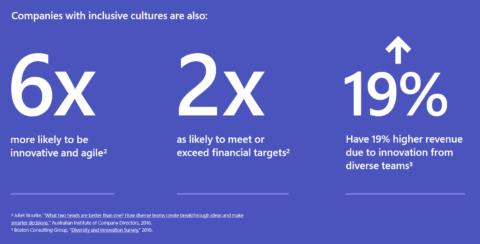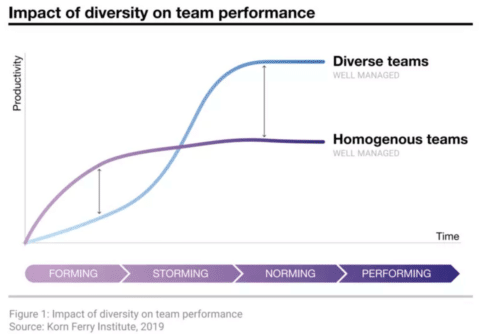There are many advantages to improving corporate diversity. According to data from Microsoft, organizations with an inclusive work culture have three times more employee engagement, six times better innovation, and 19% higher revenue than those that don’t. But inclusivity isn’t something that just happens on its own. Creating a workplace culture that supports diversity and inclusion takes conscious effort and hard work from all sides.
Diversity and inclusion: not the same in workplace culture
Before we continue, an important note: while they’re sometimes used interchangeably, diversity and inclusion refer to different concepts when it comes to fostering an inclusive culture. Diversity refers to the variety of groups represented within your workforce – in other words, its heterogeneity. On the other hand, inclusion is used to describe the experience of individuals who belong to those different groups, particularly the degree to which they are invited to participate. Diversity is easier to track with quantitative data, while inclusion requires more in-depth qualitative research and employee surveying to measure.
What does inclusive work culture mean?
There are many different inclusive company culture meanings and definitions, but we find Microsoft’s explanation most complete. According to Microsoft, “an inclusive culture is one that encourages everyone to belong, recognizes there are reasons some may feel unable to, and actively works to identify what those reasons are so the barriers can be removed.”
If diversity is what brings employees of different backgrounds into a company, inclusion is what keeps them there. In fact, without a concerted effort to perpetuate inclusion, diversity initiatives are likely to fail. When there is a lack of inclusive culture, new hires from underrepresented groups will grow quickly frustrated and leave for greener pastures.

5 ways to create an inclusive work culture
In order to fully reap the benefits of diverse voices and contributions in your organization, you need to make sure you’re creating an environment in which individuals of all backgrounds can thrive. These five initiatives for creating an inclusive workplace culture are a great place to start.
Deploy a workplace inclusivity task force
As with any company initiative, assigning responsibility to a committee that can oversee diversity and inclusion is a great place to start. Members should include high-level executives with real power to make a change within the organization. These individuals should also demonstrate a personal interest in and commitment to creating a more inclusive environment.
An inclusivity task force can set goals and create step-by-step plans to achieve them, following up regularly to evaluate results. Some of the areas the task force might get involved in include the hiring and onboarding process, employee retention, protocols for crisis management, and company policies.
Write a diversity statement
Your company’s workplace inclusivity task force can also be responsible for coming up with a diversity statement. This is a delicate task that requires careful wording and thoughtfulness to ensure that the result aligns with company goals and doesn’t inadvertently exclude anyone. Don’t be afraid to look to examples for inspiration. For example, this diversity statement from Dreamwidth Studios is often touted as one of the best all-encompassing statements out there and has been adapted by countless organizations (with proper credit, of course.)
You may also choose to write separate internal and external diversity statements. The commitments you make to customers and the community at large are often vastly different from the commitments you make to your employees. Writing separate statements can show further dedication to addressing the unique needs of these internal and external stakeholders. Make sure the statement is communicated and reflected in your internal communications.
Provide leadership with training
Once an inclusivity initiative has been deployed, it’s up to company management to propagate it. This is impossible to do without sufficient training. SHRM recommends a well-rounded diversity training program that includes recognizing unconscious bias, managing diverse teams, and taking responsibility for the culture within their own departments. Managers and leadership should also be regularly evaluated based on how well they carry out diversity and inclusion initiatives by tying success into their performance reviews.
Listen and respond to employee feedback
As you work towards creating a more inclusive work culture and a sense of belonging, it’s essential to recognize that you won’t get everything right the first time – and that’s okay. Listening to employees and responding to feedback is the best way to improve over time and ensure that inclusivity initiatives are serving their intended purpose. This invaluable insight will keep you accountable along the way. Besides, creating an environment in which employees feel comfortable communicating feedback is a core component of workplace inclusivity.
Set goals and track progress
As an organization, you need to decide what your goals are related to diversity and inclusion and keep regular track of the data used to measure them. This might involve more diverse representation among your employees or improved retention of new hires from underrepresented groups.
In 2015, Twitter released a statement in which the company publicly committed to increasing the representation of women and minorities in tech and leadership roles. This is a great example of using quantitative data to measure diversity and inclusion efforts.
How does technology help foster inclusive culture in the workplace?
In the global movement towards better workplace inclusivity, it might feel obvious that technology can be a useful tool. Surprisingly, however, this isn’t always the case. Bias can easily make its way into technology without a concerted effort to make programs and systems more inclusive.
Can technology really be biased?
While computers and code are incapable of feeling prejudice in the same way that a human does, there are many recorded cases of bias in technology. For example, facial recognition systems sometimes don’t recognize features of people of certain ethnicities or with nonconforming physical appearances. Any case in which an individual is unable to use workplace technology due to poor inclusivity in the design process can easily destroy the employee experience.
Making sure technology supports an inclusive culture
With some careful planning, technology can still be an overwhelmingly positive force in building an inclusive culture in the workplace. There are many examples of this, from HR software that helps hiring managers recruit more diverse candidates to language programs that flag words and phrases that may suggest exclusivity.
One common platform that can be a great asset in building an inclusive workplace culture is your intranet. An intranet supports connections between all employees regardless of location and encourages diversity by bringing different groups together. Built-in accessibility features like multi-lingual content make it easy for everyone to participate, regardless of linguistic capabilities.
Ensure that your diverse workforce gets the most out of your intranet with an inclusive solution like Powell Intranet. Our intuitive platform makes adoption and management a breeze.





